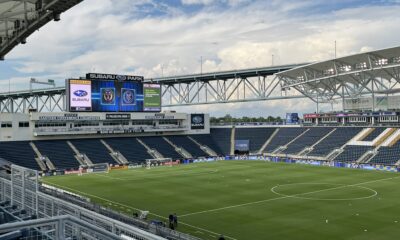Brotherly Game Archive
The counter attack that nearly broke New England
A breakdown of the first half counter attack against New England
The Philadelphia Union are built back to front, which makes their clean sheet in Wednesday night’s performance against the New England Revolution an optimal example of why they can compete for an MLS title in 2020.
Despite a slight edge in possession and corner kicks, the Revolution forced Andre Blake to make only one save from a wide angle in the 9th minute, and Mark McKenzie and Jack Elliott stopped goal-scoring opportunities in each half to keep New England in check. With tightened marking and numbers around the ball, the Union withstood a late-game charge from the Revs and earned a valuable road point.
However, the Union sputtered when creating opportunities in the offensive third and are still finding the rhythm and balance attributed to the stop and go of the 2020 season. Their most dynamic goals in the MLS is Back Tournament came from counter-attacks: Kacper Przybylko’s goal against Miami, Ilsinho’s opener against Orlando City, and Sergio Santos’ first goal against Sporting KC where he outran the entire Disney complex, including Dash from The Incredibles.
Against the Revs, the Union nearly pulled off another stunning counter-attack, something that is becoming their most dangerous attacking threat.
While defending a corner kick in the 35th minute after absorbing a wave of New England pressure, the Union won the ball and found Jamiro Monteiro in the middle third with space. Brenden Aaronson pushed wide to the left, Ray Gaddis drifted wide to the right, and Sergio Santos made a surging run down the middle, which provided enough unpredictability for the ensuing sequence to play out. Monteiro easily beat Gustavo Bou inside the Revolution defensive half, and with Kacper Przybylko trailing, the Union had a numbers advantage pressing into the final third with speed.
Monteiro found Aaronson wide left with space one-on-one with a Revolution defender. Aaronson cut inside and passed to Przybylko, who settled into the space left when Santos drew both central defenders. Przybylko’s first touch was heavy but he managed a low shot with his left foot inside the near post that Rev’s keeper Matt Turner pushed aside for a corner.
The Union did not score, yes, but when looking at the counter with more depth, the sequence and spacing showed how the Union are finding that attacking identity. Let’s start with Monteiro in midfield. There aren’t many other players in the MLS better one-on-one in midfield than Monteiro. This was an easy victory for him against an attacking player, and his decision to beat Bou and not pass is what really set this break in motion.
Aaronson’s positioning wide was excellent as well. He’s been the Union’s best attacking player since the restart in July and warrants those talks of overseas interest. I hate using a qualifier for him but I have to. He’s still 19. His role as an attacking midfielder is vital to the Union’s success going forward, but he’s looked uncomfortable from certain central positions, especially with his back to goal, something that is normal in player development and will certainly improve as he’s given more chances in those situations.
The counter represents one of his strengths. It took Ronaldo years to find his dominance on the wide left. The same with Messi on the wide right. Not that Aaronson needs any pressure from those comparisons, but he thrives in the wide left position. Go back to the Miami counter goal, which most resembled this attack against the Revolution. Aaronson received the ball wide left and was able to cut in and find Przybylko across the box.
Look at the Orlando City goal, Aaronson cutting in and finding Bedoya who quickly moves it to Ilsinho. Even the late-offsides goal against the Portland Timbers is comparable. Again, Aaronson found space wide and cut in, but unfortunately Przybylko’s toe was offsides. Aaronson is at his best wide left with the ball at his feet in space facing the goal.
A brief digression, but add Ilsinho’s presence on the wide right, and the Union have opposing threats facing goal in space from wide positions, which is why when they split into a 4-3-3 or 4-2-3-1 after Ilsinho comes into the game, they look more dynamic offensively. But for obvious reasons, that’s not a 90-minute scenario.
Przybylko is another key player in this sequence. After scoring fourteen goals in 2019, Przybylko has had less of an impact on the scoresheet in 2020. He’s appeared out of sync at times and has struggled to find games, and three of his goals in the MLS is Back Tournament were ruled offsides. Some of it may be due to rust, rhythm, or playing alongside multiple partners, all typical of strikers who need games against opponents to find themselves. He’s a forward who excels more between the sixes than between the eighteens and is better at finding space than creating it, which is why this counter-attack plays to his strength, running off the ball and squeezing that void left by the Santos run.
But two factors affected Przybylko’s shot: positioning and touch. Santos’s run may have confused the New England center backs but it also confused Przybylko. Santos already occupied that high line, so as Przybylko charged ahead, he got in his own way. He’d already been positioned behind the ball, so his patience in a delayed run makes a big difference in the rhythm of his shot. He received the ball stationary and had to take a touch to generate forward momentum. His back was also to Gaddis on the far side, which may or may not have limited his options. Przybylko’s positioning influenced his touch. If he delayed his run a second or two longer Aaronson could have played the ball into space ahead of him. And Przybylko attacking the ball moving forward may have produced an outcome that more resembled his Miami goal than what transpired in this attack.
So what is the Union’s current offensive identity? They’ve scored different types of goals, some from the run of play, some from free-kicks, but their counter attacks may define the success of the 2020 season. Built from the back but pushing forward with pace and numbers, they’re most unpredictable when finding creative players with space facing the goal. In the future, who knows? Opponents may find that the Union are toughest to defend from their own corners.























